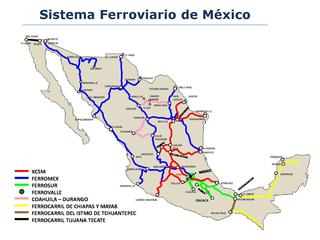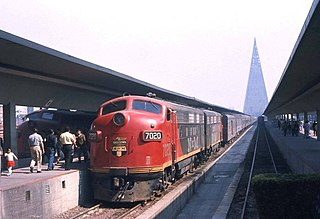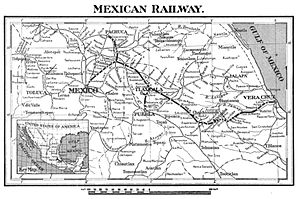
Ferromex is a private rail consortium that operates the largest railway in Mexico with combined mileage of 12,100 kilometres (7,500 mi) and is part of the North American Class I railroads.

The Second Mexican Empire, officially the Mexican Empire, was a constitutional monarchy established in Mexico by Mexican monarchists in conjunction with the Second French Empire. The period is sometimes referred to as the Second French intervention in Mexico. French Emperor Napoleon III, with the support of the Mexican conservatives, clergy, and nobility, established a monarchist ally in the Americas intended as a restraint upon the growing power of the United States. It has been viewed as both an independent Mexican monarchy and as a client state of France. Invited to become emperor of Mexico by Mexican monarchists who had lost a bloody civil war against Mexican liberals was Austrian Archduke Maximilian, of the House of Habsburg-Lorraine, who had ancestral links to rulers of colonial Mexico. His wife and empress consort of Mexico was the Belgian princess Charlotte of the House of Saxe-Coburg and Gotha, known in Mexico as "Carlota".

The San Diego and Arizona Eastern Railway Company is a short-line American railroad founded in 1906 as the San Diego and Arizona Railway (SD&A) by sugar magnate, developer, and entrepreneur John D. Spreckels. Dubbed "The Impossible Railroad" by many engineers of its day due to the immense logistical challenges involved, the line was established in part to provide San Diego with a direct rail link to the east by connecting with the Southern Pacific Railroad lines in El Centro, California.

Railways with a track gauge of 3 ft 6 in were first constructed as horse-drawn wagonways. The first intercity passenger railway to use 3 ft 6 in was constructed in Norway by Carl Abraham Pihl. From the mid-nineteenth century, the 3 ft 6 in gauge became widespread in the British Empire. In Africa it became known as the Cape gauge as it was adopted as the standard gauge for the Cape Government Railways in 1873, although it had already been established in Australia and New Zealand before that. It was adopted as a standard in New Zealand, South Africa, Indonesia, Japan, the Philippines, Taiwan, and Queensland in Australia.

Mexico has a freight railway system owned by the national government and operated by various entities under concessions (charters) granted by the national government. The railway system provides freight and passenger service throughout the country, connecting major industrial centers with ports and with rail connections at the United States border. Passenger rail services were limited to a number of tourist trains between 1997, when Ferrocarriles Nacionales de México suspended service, and 2008, when Ferrocarril Suburbano de la Zona Metropolitana de México inaugurated Mexico's first commuter rail service between Mexico City and the State of Mexico. This is not including the Mexico City Metro, which started service in 1969.

Ferrocarriles Nacionales de México was Mexico's state owned railroad company from 1938 to 1998, and prior to 1938, a major railroad controlled by the government that linked Mexico City to the major cities of Ciudad Juárez, Nuevo Laredo and Matamoros on the U.S. border. The first trains to Nuevo Laredo from Mexico City began operating in 1903.

The Southern Pacific Railroad of Mexico was a railroad subsidiary of the Southern Pacific Railroad in Mexico, operating from Nogales, Sonora, to Mazatlán, Sinaloa. The Sonora Railway was constructed by the Atchison, Topeka and Santa Fe Railway between 1879 and 1882. In 1898 the Santa Fe leased the Sonora Railway to the Southern Pacific in return for the latter railroad's line from Needles to Mojave, California. This arrangement continued until December 1911, when the Southern Pacific purchased both the Sonora Railway and the New Mexico and Arizona. The following June, the Sonora Railway became part of the Southern Pacific Railroad in Mexico."

The Interoceanic Railway of Mexico was one of the primary pre-nationalization railways of Mexico. Incorporated in Great Britain in 1888 to complete an unfinished project and compete with the Mexican Railway, it completed a 3 ft narrow gauge main line from Mexico City to Veracruz in 1891. Branches included Mexico City to Puente de Ixtla, Puebla to Cuautla, Atencingo to Tlancualpicán, and a cutoff between Oriental and Santa Clara. Through subsidiary Mexican Eastern Railroad, the Interoceanic acquired a branch from San Marcos to Teziutlán in 1902, and in January 1910 it began operating the Mexican Southern Railway from Puebla to Oaxaca under lease. The Mexican government acquired control of the Interoceanic in 1903, and subsequently sold it to the National Railroad of Mexico in exchange for ownership of that company.

Guatemala has a network of 914 mm narrow gauge railroads, passenger and freight trains currently run.

Enrique Clay Creel Cuilty, sometimes known as Henry Clay Creel was a Mexican businessman, politician and diplomat, member of the powerful Creel-Terrazas family of Chihuahua. He was a member of the Científicos, as well as founder and president of the Banco Central Mexicano, vice-president of Kansas City, Mexico and Orient Railway, as well as governor of Chihuahua on two occasions, ambassador of Mexico to the United States, and Minister of Foreign Affairs of President Porfirio Díaz in the last years of his regime. The foremost banker during the Porfirato (1876-1910) he is considered a symbol of the Porfirian regime.

The Mexican Central Railway was one of the primary pre-nationalization railways of Mexico. Incorporated in Massachusetts in 1880, it opened the main line in March 1884, linking Mexico City to Ciudad Juárez, across the Rio Grande from El Paso and connections to the Southern Pacific Railroad, Texas and Pacific Railway, and Atchison, Topeka and Santa Fe Railway. Other major branches included Irapuato to Guadalajara, Chicalote to Tampico, and Guadalajara to Manzanillo. The Mexican Central acquired control in June 1901 of the Monterey and Mexican Gulf Railroad, which connected the Mexican International Railroad at Reata to Tampico, and connected its main line with this line at the Monterrey end through a branch from Gómez Palacio. The Mexico, Cuernavaca and Pacific Railroad, owner of an unfinished line from Mexico City to Acapulco, joined the system in November 1902, and in 1905 the Mexican Central bought the Coahuila and Pacific Railway, which paralleled the branch from Gómez Palacio to Monterrey and was to be operated jointly with the National Railroad of Mexico.

The Mexican International Railroad was one of the primary pre-nationalization railways of Mexico. Incorporated in Connecticut in 1882 in the interests of the Southern Pacific Railroad (SP), it opened a main line from Piedras Negras to Torreón, on the Mexican Central Railway, in 1888, and to Durango in October 1892. Branches extended from Durango to Santa Catarina de Tepehuanes and Reata to Monterrey.

The National Railroad of Mexico was one of the primary pre-nationalization railways of Mexico. Incorporated in Colorado in 1880 as the Mexican National Railway, and headed by General William Jackson Palmer of the Denver and Rio Grande Railway, it completed a 3 ft narrow gauge main line from Mexico City to Nuevo Laredo in September 1888 after an 1887 reorganization as the Mexican National Railroad. At its north end, the Texas Mexican Railway, owned since 1883, ran east from Laredo to the Gulf of Mexico at Corpus Christi; a second Gulf connection was completed in 1905 through a branch from Monterrey to Matamoros. Other branches included a cut-off from Mexico City through Querétaro to Celaya and an incomplete Pacific extension from Acámbaro to Uruapan. In 1886 the railway commissioned Abel Briquet to take a series of photographs, which provide documentation of the railways at that time.
The Ferrocarril de Veracruz al Istmo was one of the primary pre-nationalization railways of Mexico. Incorporated in West Virginia in 1898 as the Vera Cruz and Pacific Railroad, it built a line from Córdoba to Jesús Carranza on the Tehuantepec National Railway, with a branch from Veracruz to Tierra Blanca. The Mexican government gained control in May 1904 and organized the Ferrocarril de Veracruz al Istmo to operate the property under lease.

The Railway Museum of Catalonia is a museum in Vilanova i la Geltrú. The museum has a large collection of historic railway locomotives and other rolling stock in a former station and roundhouse. It is located close to the railway station in Vilanova i la Geltrú, 40 km south of Barcelona.
The following is a timeline of the history of the city of Chihuahua, Mexico.
The Mexican Southern Railroad was a passenger and freight railroad in Mexico connecting Oaxaca with Puebla. It was chartered in 1881 by a consortium of Mexican and American investors including former President Ulysses S. Grant. Construction delays plagued the company and by 1885, it was bankrupt. Under new ownership, construction was completed in 1892. The line became profitable for its owners until nationalized in 1936.

Lechería is a commuter railway station serving the Ferrocarril Suburbano, a suburban rail that connects the State of Mexico with Mexico City. The station is located in the municipality of Tultitlán, State of Mexico, north of Mexico City.

Ferrocarriles Vascongados was a railway company in the Basque Country, Spain; founded in 1906 as the merger of three railway companies. It operated the Bilbao-San Sebastián line, as well as the Elorrio branch and the Deba railway. FEVE took over its operations in 1972, which in 1982 were transferred to the new company Basque Railways. Ferrocarriles Vascongados was dissolved in 1995, after more than two decades without activity.

















